Read The Old Magic of Christmas: Yuletide Traditions for the Darkest Days of the Year Online
Authors: Linda Raedisch
Tags: #Non-Fiction
The Old Magic of Christmas: Yuletide Traditions for the Darkest Days of the Year (21 page)
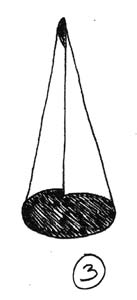
166 Winter's Bride
going to make more than one mask. Turn the cut-out quar-
ter into a cone and glue the seam. (Figure 3)
Lucka Mask Figure 2
Lucka Mask Figure 3
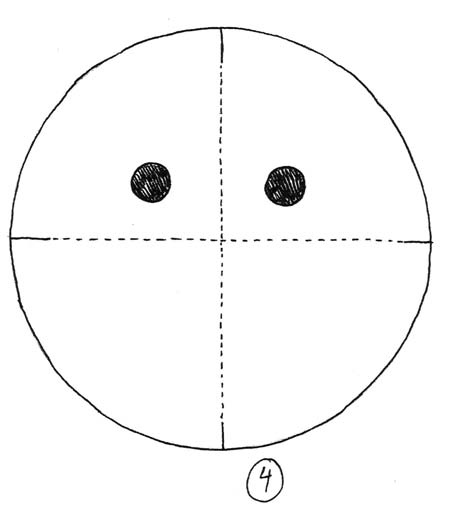
Winter's Bride 167
Using a large coin as a template, trace two eyeholes on
the small circle as shown in Figure 4. cut out eyeholes with your knife.
Lucka Mask Figure 4
Use the base of your cone to trace a circle in the cen-
ter of the mask. With your knife, divide the circle into “pie slices” as shown in Figure 5, but
do not
cut out the circle itself. Fold the “pie slices” up and back as shown in Figure 6.
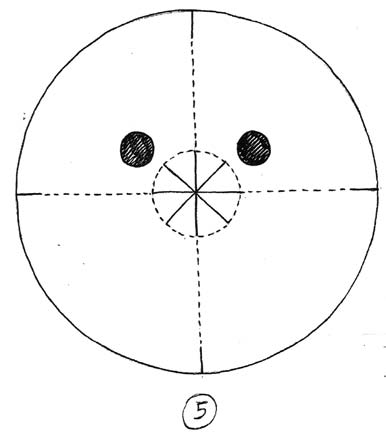
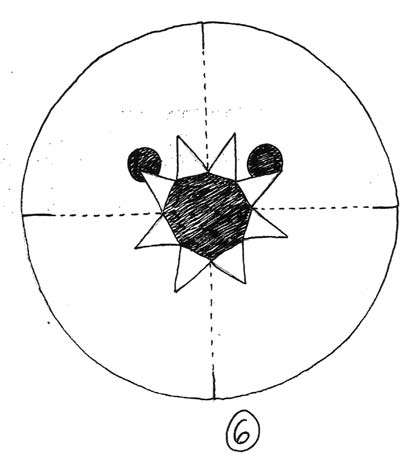
168 Winter's Bride
Lucka Mask Figure 5
Lucka Mask Figure 6
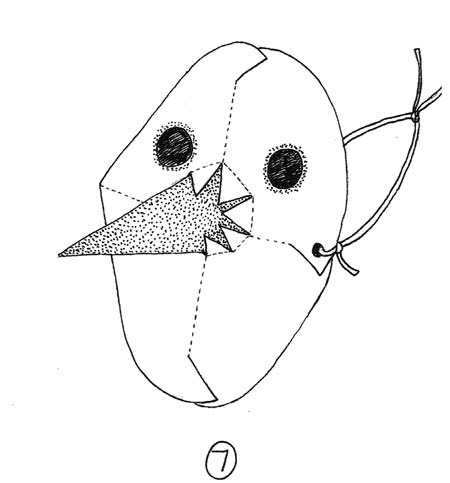
Winter's Bride 169
Slide the cone out through the hole in the center of the
mask. Glue the “pie slices” to the base of the cone to hold it in place.
It’s time to use those four cuts you made at the edge of
the mask. Starting at the forehead, slide the edges of the cut one over the other and glue in place. Do the chin next, then the cheeks. Punch a hole at the side of each cheek and tie a length of yarn or ribbon in each hole.
Figure 7 shows the finished mask with silver glitter
applied on the nose and around the eyeholes. There is no
mouth because the Lucka traditionally does not speak.
Lucka Mask Figure 7
170 Winter's Bride
Rising from the Ashes
Meanwhile, in Rosenberg, the
Lucu
, three youths dressed in white, entered the house with broom, bucket and mop.
Without a word, they proceeded to whisk and wash away
until the housewife presented each of them with a small
gift. Like the equally mysterious Slavic “Sweeper” who
entered homes silently during Advent to brush the stove
three times with her bundle of birch twigs, the Lucu’s services were more of a blessing than a thorough cleaning.
Further to the east, there was a Slovakian Lucka who
glided silently with face veiled through all the nights
between her feast day and Christmas Eve. The Slovakian
Lucka reminds us of both the Barborky and the scarecrow
brides who, not unlike those virginal Christian martyrs,
were stabbed, burned, and/or cast into rivers.
Back in Sicily, Lucia Night is celebrated with bonfires,
though the saint’s image is never thrown into the flames.
Lucia has proven herself to be one of the most resil-
ient saints, having survived the Reformation in both the
Lutheran and Anglican churches. There’s really no need
to feel sorry for her, especially when you take into account her striking resemblance to Aurora, Roman goddess of the
dawn. If not Aurora, then the first Lucia was probably some native Sicilian equivalent thereof. In Sicily, she also served as a gift-giver, coming down the chimney in her witch’s
weeds, not her saintly garments. This Lucia threw ashes in the eyes of any child she caught spying on her. The saint, we are told, gouged her own eyes out to make herself less
attractive to potential suitors, but the throwing of the ashes
Winter's Bride 171
strikes one as a reminder never to look directly at the sun or at secretive gift-givers.
Regardless of whether or not she ever actually existed,
the Sicilian Santa Lucia aspired to become the bride of
Christ. Still a virgin, she now banishes the winter darkness with a brave display of candlelight. The Lucka and Lus-sibrud on the other hand, consumed the night, taking it
with her when she left the village so that the hours of day-light might increase. In Bohemia, she was said to “drink the night.” This older Lucy was the bride of Death, the midwinter darkness her dowry. As such, she provided an invaluable service to the far-flung communities of farmers and herds-men to which she had been born. No Christian saint could
quite replace her.
With the Old Solstice behind us and Christmas on its
way, have we now seen the last of the glowing, bride-like
Midwinter Witch? No, we have not, for, as the cast-down
White Witch in
Prince Caspian
says herself, “’[W]ho ever heard of a witch that really died? You can always get them back.’”
There are Witches in the Air
It was once the custom of Austrian farm wives to go out
to the orchard at midnight on St. Andrew’s Eve (Novem-
ber 29) to break branches from the apricot trees. They
forced the branches into flower in vases at home then car-
ried them to church on Christmas Eve. The white blos-
soms must have looked quite striking against the wives’
dark wool Sunday dresses, but it was not these ladies’ intention to create a pretty tableau; the flowering apricot branch allowed the bearer to pick out any witches in the congrega-tion. What set the Austrian witch apart? Well, if you had an apricot branch, you would notice she carried a wooden pail on her head. I don’t know about witches, but the practice
must have been an effective means of identifying the par-
ish busybodies.
St. Andrew’s Day is an important fingerpost along the
road to Christmas. There are two systems in place for calculating the beginning of Advent, the ecclesiastical Christmas season. One is to count back from the fourth Sunday before Christmas Day. The other is to locate the Sunday closest to
173
174 There are Witches in the Air
St. Andrew’s Day. In most Catholic and formerly Catholic
regions, St. Andrew’s Day is the cue to start planning a happy holiday, but it is the darker occasion of St. Andrew’s Eve, and the ensuing Christmas season, which concerns us here.
Vampires
While the Austrian witches were scouring their milk pails
and Polish girls were busy pouring lead into cold water to find out when and to whom they would be married, the
Romanians had bigger problems. In Romania, St. Andrew’s
Eve was not a night to go out, let alone to go wandering
in the orchard. It was not enough to lock the doors; before dark, all apertures had to be thoroughly rubbed with a
peeled garlic clove, for on this night the vampires clawed their way out of their graves and walked again. Carrying
their coffins portage-style, they paraded into the village to circle their former homes before taking themselves to the
crossroads to engage in a pitched battle, no doubt with the vampires of the neighboring village.
A cross placed, chalked or painted over a door or cat-
tle stall imparts protection to the occupant, but a cross
roads
has always been the haunt of witches and other malevolent spirits, perhaps because suicides were buried and outlaws left to rot there. The Apostle Andrew whose night this is was martyred on an X-shaped cross. His feast day marks
a crossroads within the year, for it was acknowledged in
much of Europe as the true beginning of winter.
Joining these more usual vampires at the crossroads
were the village’s congenital vampires. This could be a seventh son or an individual whose mother had neglected to
pull out the one or two teeth with which he had been born.
There are Witches in the Air 175
The soul of this kind of vampire left his sleeping body as a blue flame flying out through the mouth. Between home
and the crossroads, it assumed the shape of that vampire’s personal animal, so even the nosy neighbor who was brave
enough to peer out the window would have no idea to
whom the fiery blue dog flying by might belong. Cockcrow
sent both species of vampire scuttling back to their graves and their beds on the morning of St. Andrew’s Day.
In his mammoth work,
The Golden Bough
, Sir James
George Frazer describes another sort of “vampyre” afoot in Romania. This one might be kept at bay with the “need fire”
which was kindled afresh after all fires in the community
had been extinguished. The need fire was used to purify
and protect the cattle from diseases which these vampires
were thought to cause. Unlike Bram Stoker’s or Stephenie
Meyer’s undead, these vampyres were incorporeal.37 Frazer
contrasts them with “living witches,” classing them instead with “other evil spirits.” Though filtered first through German and then through French, the term “vampire” arrived
in English almost untouched from Serbian. The word is
so old that its etymology is uncertain, though it may have come from the Turkish
ubyr
which means simply “witch.”
Down with a Bound
Long before the introduction of “floo-powder,” there was
already a lot of coming and going through the fireplace flue as the witches floated nimbly both up and down the chim-bley. In Somerset, the general consensus was that witches
37. For a thorough treatment of some distressingly corporeal vampires, see Paul Barber’s
Vampires, Burial and Death
, if you have the stomach for it.